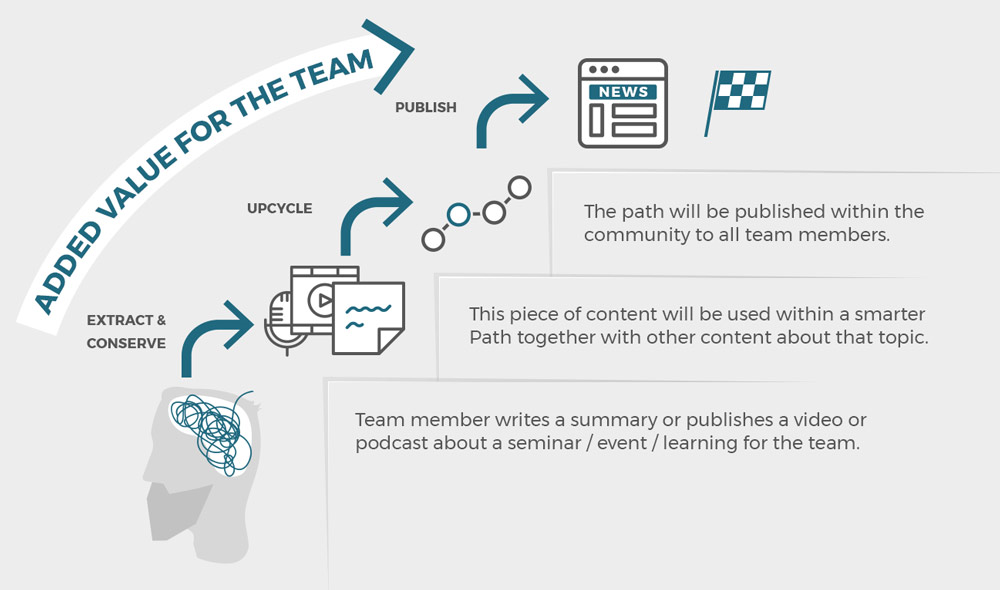Pokeshot CPO Sandra Brückner talks to Reinhard Heggemann von „Das Wissensmanagement“ about how to extract and make visible the knowledge that is stored in the minds of employees, about the role of corporate communications, and about implementing the “Learner as Creator” concept. This interview ties in with Sandra’s previous article on the four steps of content upcycling.
Sandra Brückner:
I saw on your website that you talk about the six steps to successful knowledge management. Could you briefly summarize these steps and what they involve?
Reinhard Heggemann:
The first step for those who want to introduce or initiate knowledge management within a company is to continuously ask yourself the fundamental question: What am I aiming for and what knowledge do I need to get there? This applies both at the company level and at a personal level. Everyone should always ask themselves: What am I aiming for, what are my goals, and what do I need to know in order to achieve them? Otherwise, the knowledge transfer and knowledge management processes won’t have a clear target. That is the first step.
The second step is to ask yourself: What knowledge already exists within the company and its employees? What knowledge do I, myself, possess? As Heinrich von Pierer of Siemens once said: “If Siemens only knew just how much Siemens knows, it would have a bigger bottom line.”
The third step consists of structuring this knowledge. At this point I want to distinguish between two important categories: knowledge that can be described, and that which is less easy to describe. There is a huge amount of knowledge held by employees that is hard to relate to others. Try explaining to someone the process of riding a bike, for example. It’s really difficult. It is important to realize from the outset that most people won’t even try to share the kind of knowledge that they find difficult to describe.
That brings us already to the fourth step, which is sharing and passing on knowledge, and the fifth step, which is growing and developing new company knowledge. This new knowledge can sometimes come from the company or the employees themselves by addressing the question: What do I want to know, or what do we need to know? This is the biggest challenge: generating knowledge and retaining that knowledge. But, generally speaking, I can use co-creation and other methods to produce new knowledge within my team.
The sixth step is knowledge maintenance. It is important to continuously reflect on which knowledge is still relevant, on what you still need, and on how you can integrate accumulated knowledge into competence development. So this means constantly introducing learning tidbits – little bite-sized learning modules – in a separate sphere to the classic staff development activities like seminars and workshops. They certainly have their place, but it is equally important to enable the knowledge that has originated within the company itself to flow back into company processes. That is the only way to achieve a truly holistic approach to knowledge management. And these are also the conditions that I believe constitute successful knowledge management.
Reinhard Heggemann: Six steps to successful knowledge management
Sandra Brückner: We developed a similar model at Pokeshot that we call Content Upcycling. This involves processing the knowledge that exists in the minds of employees into intelligent learning pathways. You talk about “making knowledge visible” – what do you take that to mean?
Reinhard Heggemann: Here, again, I see two levels. One is the level of company knowledge: Who in the company knows what? Who are the knowledge carriers and what knowledge do they have? Then there is the personal level: What knowledge do I have? And employees have to be brought in on this. Every employee needs to ask themselves: What knowledge does my day-to-day work require and what do I use? If employees go through their entire working day, they will realize that there is a huge amount of knowledge involved in their day-to-day tasks that they weren’t even aware of before. This is the hidden and valuable knowledge contained within the minds of a company’s employees.

Sandra Brückner: “The content upcycling process”
Sandra Brückner: What can companies do? Are there methods they can employ to make this knowledge visible?
Reinhard Heggemann: Yes. First of all, as I already mentioned, they can look at the company from top to bottom and ask themselves: Who knows what? This question can also be geared toward business processes: What knowledge is contained within each business process? In sales and marketing, for example, you will usually find the process “identifying customer needs.” So here I first need to find out what knowledge exists within my sales team: How do they figure out what the customer wants? What methods do they use? And so on. I can use this approach to analyze every process within the company and combine these analyses to form a knowledge map.
When it comes to individual knowledge, I already mentioned one method: Employees have to ask themselves what they already know. They need to examine their working processes and go over these steps – perhaps with other colleagues.
The next point relates to structure. Is this knowledge actually relevant? Here I can start with each individual and expand it to the whole company. Then the company should ask itself: Has this knowledge already been documented? Can it in fact be documented and formalized or not? If not, it should still be noted down and shared. This is how I can make employee knowledge and, thus, the knowledge of the entire company visible. It’s a challenge, but it works.
Sandra Brückner: Speaking of challenges, what are the greatest challenges involved in getting knowledge out of employees’ heads and making it visible?
Reinhard Heggemann: The company or management team can’t just say, “We’re now doing knowledge management,” and get everyone to enter their knowledge into some kind of system. That’s not how it works. It’s been tried many times in the past and it has always failed. I frequently notice in kick-off workshops that people need time and space when it comes to knowledge management. This means that I, as a company, have to give people this time in order for knowledge to be transferred. That is an investment, but it pays off.
The second point is transparency, which is becoming an increasingly important topic for employees. They want to know: What actually happens to the knowledge that I give to others? What are other people sharing? What do I get out of it, and what do others get out of it? And this transparency is also expected from management – employees want to see the management team employ an equally open approach to knowledge sharing. There has to be a general culture of openness.
Thirdly, I recognize time and again that there is a need for tolerance toward mistakes. Mistakes must be accepted and openly acknowledged. Mistakes are a positive thing. Everyone should be allowed to make mistakes and not only have them excused, but in fact be appreciated. Many employees shy away from sharing their knowledge with others for fear of making mistakes. Appreciative corporate communications are extremely important, therefore, when it comes to encouraging employees to pass on their own knowledge to others. It’s a psychological issue: “I’m not going to share anything if I don’t feel appreciated.”
So these are some of the challenges that I frequently encounter in kick-off workshops in terms of what employees want. I also often notice that, even if these approaches exist in theory in the company rulebook, it is not necessarily the experience of the employees – both on a small and larger scale. So this needs to start actually being felt, otherwise no one is going to have the motivation to share their knowledge.
Sandra Brückner: Okay. In terms of the progress of companies and perhaps even industries, how far along are they when it comes to making knowledge visible? Also with regard to supporting the learners, as you were just saying, through trust, transparency, and creating structures. What progress has been made in this respect? Particularly here in Germany.
Reinhard Heggemann: There’s an entire spectrum that ranges from very far along to not even at the starting line – by which I mean the company culture has zero interest in sharing knowledge or even make it visible in the first place. So it’s very, very varied.
Sandra Brückner: Are these differences attributable to company size or particular industries? Or are you saying that it is completely open?
Reinhard Heggemann: It’s completely open. There are some mid-sized companies with a corporate culture that is very strongly committed to the concept, and without which they would never have got to where they are today. Even if they are perhaps organized in a very patriarchal way. If the boss’s door is always open to employees, a great deal can be achieved. With large companies, you will find more knowledge management systems already in place. Although I just recently spoke with an employee at a large corporation who said, “We’re doing absolutely nothing on that front.” Quite the opposite. So you really can’t attribute the differences to specific sectors. It’s very varied.
Sandra Brückner: One last question: What is the first thing that comes to mind when you hear “Learner as Creator”?
Reinhard Heggemann: I think that’s the really exciting part. For me, that is the essence of the whole thing. Because this is the element that closes the circle within a learning organization – by which I mean the process of discovering knowledge within a company and then passing it on to others in the form of little knowledge bites. These could be in the form of short learning modules, perhaps a simple PowerPoint, or a micro article written up after a meeting. These are all ways that a company can close the circle of knowledge growth and pass the knowledge extracted from certain employees on to others. If I have knowledge I want to pass on, it has to first be created, it has to be given a form. That also means not simply distributing documents, but to pass on the very essence of these documents and also to reflect on it personally. That is an important aspect of knowledge transfer. It’s not about what I happen to think is really interesting right now, but what do others need and what could others really use in their work. What would benefit them. And it’s about using this perspective to create new knowledge within the company.
Sandra Brückner: Thank you very much, Reinhard, for taking the time to talk to us about this topic.
Reinhard Heggemann: My pleasure, thank you for asking me. It is always great to be able to pass on my knowledge.
THE INTERVIEWEE

Reinhard Heggemann has worked as a business consultant and concept developer for knowledge management and e-learning for 13 years. He develops solutions that make the know-how and process knowledge behind a company’s day-to-day work visible, structured, and available to all employees. His methods can be used to expand and maintain company knowledge through strategic competence development.

Sandra Brückner, who studied business informatics at the Technical University of Dresden, has worked as social business consultant since 2012. She joined the Berlin-based social business consultancy and technology provider Pokeshot in the beginning of 2014 and has served for more than two years as Chief Product Officer for all products.
Connect with us on facebook | twitter | LinkedIn | YouTube – we will keep you posted!

1 thought on “MAKING A COMPANY’S KNOWLEDGE VISIBLE – INTERVIEW WITH REINHARD HEGGEMANN”